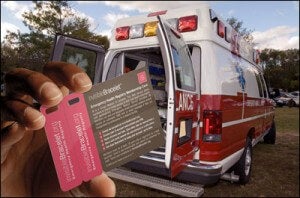Invisible Bracelet Shares Emergency Medical Information and Contacts Loved Ones

Share

Talking while you're having a heart attack or stroke isn't easy. Yet there's important information (allergies, health conditions, current medications) that emergency medical personnel need when providing on the spot care or transporting you in an ambulance. That's why Tulsa-based Docvia started InvisibleBracelet.org. By registering with Invisible Bracelet (IB), prospective patients can provide all the pertinent data that EMS will need during an emergency and store it in a system that is only accessible by medical professionals. When that information is accessed by EMS, IB will contact up to 10 loved ones and alert them to your hospital destination. Each IB member has their information connected to a special membership card and fobs for key rings and backpacks. The cost is about $5 per member per year. According to the AP, Invisible Bracelet has been adopted as an optional benefit for government employees in Oklahoma, and the American Ambulance Association is working with Docvia on a related database. Soon, medical professionals may be encouraging everyone to register on this or a similar web service.
Medical information is increasing quickly, and related databases are growing along with it. Emergency care information and in-case-of-emergency contacts are only the most rudimentary form of data that we may wish to carry around with us. Electronic medical records (and a national database of them) could help us get better care when we arrive at hospitals. These records are generally compiled doctor's reports, but could also expand to include the data from day to day health monitoring. As at-home health monitoring becomes more sophisticated patients will want to leverage that added information to get more personalized (and hopefully successful) health care. The short of it is that medical professionals will have more that they will need to know and we need to have a system that provides them with the information they require.
Already, IB has seen some success in its opening program in Oklahoma. More than 100,000 people have registered, it's an optional benefit for state employees, and the University of Oklahoma is looking to adopt it into a campus registry. There isn't any reliable results to show that IB has saved any lives, but it would seem to be gaining popularity nevertheless.
Be Part of the Future
Sign up to receive top stories about groundbreaking technologies and visionary thinkers from SingularityHub.


Medical record systems and privacy concerns go hand in hand. IB has done what it can to make its registration fairly painless and its access very secure. After enrolling online and filling out contact info and medical data, patients receive fobs and a membership card in the mail. These cards have a secure PIN that has to be relayed back to InvisibleBracelet.org to complete registration. Emergency contacts have to likewise contact IB to consent to receiving alerts. IB keeps audit logs of all access to medical information and those providers registered with IB must maintain employee records so that former EMS workers can't access the database. As far as I can tell, Docvia seems to be jumping through all the right privacy-security hoops.
But I'm still not convinced that fobs and cards are the way medical alert systems should develop. There are competing systems based on call-in databases, flashdrives, and RFID implants. Call-in systems are likely to be very similar to IB, with a bracelet notifying workers to call the number where their info is stored. Flashdrives certainly could provide more on-the-spot medical information which will be useful when we all start monitoring our health more rigorously. But they are also more easily damaged during trauma. RFID implants...well you certainly couldn't lose them, and they could link to a web-based system just as easily as cards. Still, whenever I mention RFID implants I have to put on my conspiracy theory hat..and anyway, let's just say that such tags are a firm possibility and could work just as well as other systems.
It's going to take several years before national (or international) shared medical databases are complete enough so that anyone showing up at a hospital (or picked up by an ambulance) doesn't have to worry about providing their own medical information. In the meantime, companies like Docvia are poised to make a killing by helping you provide the same service for yourself. Not that I'm complaining about IB's costs, $5 is certainly reasonable. As we start to combine genetic information (maybe even whole genome sequences) with daily health monitoring, the massive amounts of data are going to need a dedicated system to relay, sort, and analyze them. Some form of carry-your-own medical information device or service is going to have to be adopted in the short term. It may just be an "invisible bracelet". Of course, considering how much info there is to carry, maybe Wonder Woman's "invisible jet" would be a better option.
[photo credit: InvisibleBracelet.org]
Related Articles

Single Injection Transforms the Immune System Into a Cancer-Killing Machine

This Light-Powered AI Chip Is 100x Faster Than a Top Nvidia GPU

This Week’s Awesome Tech Stories From Around the Web (Through December 20)
What we’re reading